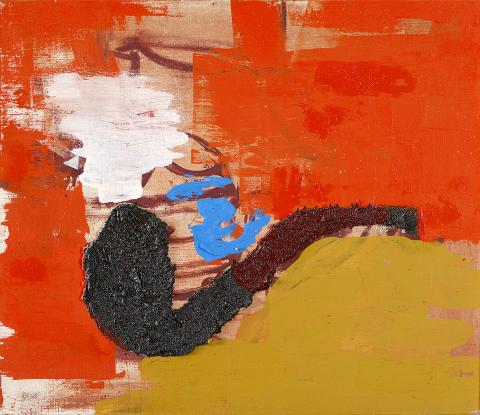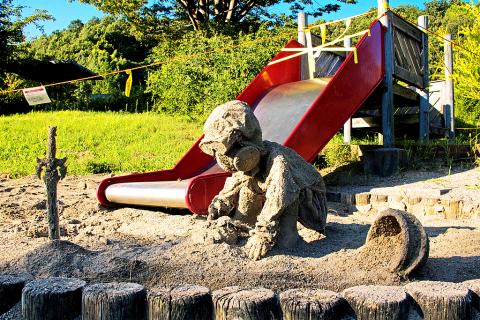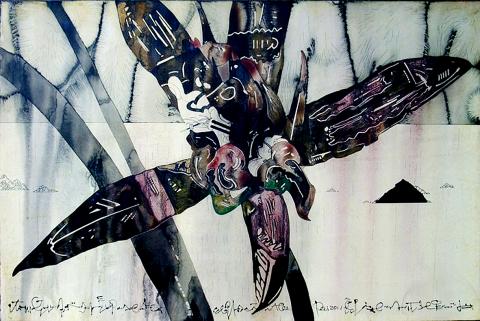Yeh Chu-sheng (葉竹盛) returns to Nou Gallery (新畫廊) with 29 new paintings in Wonderland of the Heart (喚心造境). The canvases on show are of two styles. Yeh’s abstract expressionist works meditate on the fluctuating states of the rational and irrational, the conscious and subconscious, in bold paintings that are punctuated here and there with religious symbolism, while his realist works take flowers and plants as their primary subject matter to signify how the natural environment can enlighten the human mind.
■ Nou Gallery (新畫廊), 232, Renai Rd Sec 4, Taipei City (台北市仁愛路四段232號), tel: (02) 2700-0239. Open Tuesdays to Sundays from 11am to 7pm
■ Opening reception on Saturday at 3:30pm. Until April 15

Photo courtesy of Nou Gallery
Beautiful World: Survival Dance is a solo show by Chim Pom, a Japanese artist collective consisting of five males and one female who work in sculpture, video and photography and examine how natural disasters affect society.
■ Project Fulfill Art Space (就在藝術空間), 2, Alley 45, Ln 147, Xinyi Rd Sec 3, Taipei City (台北市信義路三段147巷45弄2號), tel: (02) 2707-6942. Open Tuesdays to Sundays from 1pm to 6pm
■ Opening reception on Saturday at 4pm. Until April 15

Photo courtesy of Project Fulfill Art Space
Staying on the theme of disaster, the JUT Foundation for Arts and Architecture (忠泰建築文化藝術基金會) presents Making as Living, an exhibition and forum, mounted in collaboration with Japan’s 3331 Arts Chiyoda, that documents the various engagements undertaken by artists and activists following the magnitude 9.0 earthquake and tsunami that devastated parts of northeastern Japan in March last year. The exhibit consists of 14 filmed interviews with leading figures in the regeneration process as well as documents on the diverse activities of 80 artists, architects, designers and activists.
■ Chung Shan Creative Hub (中山創意基地), N1 Exhibition area (N1展區), 21, Minsheng E Rd Sec 1, Taipei City (台北市民生東路一段21號), tel: (02) 2562-5101. Open Tuesdays to Sundays from 10am to 6pm
■ Opens Friday. Until April 8

Photo courtesy of Art Den
Pai Tsung-chin (白宗晉) seeks to blur the distinction between abstraction and realism with his solo show In the Form of Flowers (花華法畫). Pai’s working method is to splash watery ink onto a large sheet of paper, allow it to disperse freely across the surface, and then dry. He then adds his own representational flourishes such as flowers.
■ Art Den (藝研齋), 3F, 309, Xinyi Rd Sec 4, Taipei City (台北市信義路四段309號3樓), tel: (02) 2325-8188. Open Mondays to Fridays from 11am to 5pm, and Saturdays from 10am to 6pm
■ Opening reception on Saturday at 3pm. Until March 31
The Kuandu Museum will open two exhibits on Friday. Interiors and exteriors, dreams and waking life and the figurative and the literal are themes that emerge from Chen Hui-chiao’s (陳慧嶠) installation Beyond the Tree and Clouds (樹上的雲). Combining natural and artificial elements — photos, sound and objects culled from nature — Chen’s work offers an environment where the viewer can ponder a “sense of space of sky meeting earth,” according to the museum’s press release. Visual Rhetoric of a Generation (同代人的視覺修辭) presents three thematically linked solo exhibits of photography and painting by Jen Hsiao-lin (任小林), Jing Ke-wen (景柯文) and Chang Hsiao-tao (張小濤).
■ Kuandu Museum of Fine Arts (關渡美術館), 1 Xueyuan Rd, Taipei City (台北市學園路1號), tel: (02) 2893-8870. Open Tuesdays to Sundays from 10am to 5pm
■ Exhibitions begins Friday. Beyond the Tree runs until April 22. Visual Rhetoric runs until April 29

In the March 9 edition of the Taipei Times a piece by Ninon Godefroy ran with the headine “The quiet, gentle rhythm of Taiwan.” It started with the line “Taiwan is a small, humble place. There is no Eiffel Tower, no pyramids — no singular attraction that draws the world’s attention.” I laughed out loud at that. This was out of no disrespect for the author or the piece, which made some interesting analogies and good points about how both Din Tai Fung’s and Taiwan Semiconductor Manufacturing Co’s (TSMC, 台積電) meticulous attention to detail and quality are not quite up to

Chinese Nationalist Party (KMT) Chairman Eric Chu (朱立倫) hatched a bold plan to charge forward and seize the initiative when he held a protest in front of the Taipei City Prosecutors’ Office. Though risky, because illegal, its success would help tackle at least six problems facing both himself and the KMT. What he did not see coming was Taipei Mayor Chiang Wan-an (將萬安) tripping him up out of the gate. In spite of Chu being the most consequential and successful KMT chairman since the early 2010s — arguably saving the party from financial ruin and restoring its electoral viability —

It is one of the more remarkable facts of Taiwan history that it was never occupied or claimed by any of the numerous kingdoms of southern China — Han or otherwise — that lay just across the water from it. None of their brilliant ministers ever discovered that Taiwan was a “core interest” of the state whose annexation was “inevitable.” As Paul Kua notes in an excellent monograph laying out how the Portuguese gave Taiwan the name “Formosa,” the first Europeans to express an interest in occupying Taiwan were the Spanish. Tonio Andrade in his seminal work, How Taiwan Became Chinese,

Toward the outside edge of Taichung City, in Wufeng District (霧峰去), sits a sprawling collection of single-story buildings with tiled roofs belonging to the Wufeng Lin (霧峰林家) family, who rose to prominence through success in military, commercial, and artistic endeavors in the 19th century. Most of these buildings have brick walls and tiled roofs in the traditional reddish-brown color, but in the middle is one incongruous property with bright white walls and a black tiled roof: Yipu Garden (頤圃). Purists may scoff at the Japanese-style exterior and its radical departure from the Fujianese architectural style of the surrounding buildings. However, the property